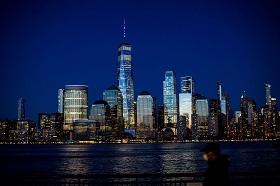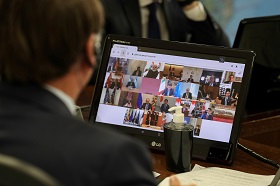Two distinct but overlapping international agendas shape the complex global environment. The first reflects the concerns of the twentieth and early twenty-first centuries; the second reflects new and emerging threats. The old world agenda is disintegrating quickly and the new one is yet to be set. As a result, the world has entered a period of increasing instability, volatility, and uncertainty. To minimize the risk of armed conflict and to shape the new agenda, major powers, regional organizations, and international institutions should focus on developing confidence-building measures in technical or regionally specific areas, such as arms control agreements, to build consensus and create acceptable dispute-resolution mechanisms. As consensus builds, new voluntary agreements on emerging challenges and on international rules, norms, and regimes should be developed. In this way, major powers and rising powers can work together to manage the risk of armed conflict and create a more inclusive system of global governance.
Globalization has shaped world affairs for many decades, but the dynamics of the globalization process have turned out more complicated and less linear than many experts anticipated in the late 1980s and early 1990s. It was assumed then that waves of globalization would spread mainly from the economic, political, and technological “core” of the Western world to the “periphery,” or the residual rest. Large “semi-peripheral” countries — such as Brazil, China, India, Russia, and others — would become transmission mechanisms linking the “global core” to the “global periphery.” Consequently, experts predicted that countries moving closer to the core (or, to the West) would embrace globalization, while resistance to globalization would increase as countries moved toward the periphery. These peripheral countries would also be more nationalistic and isolationist, and more likely to generate trade wars and conflict.
However, events of the early twenty-first century suggest that, in many cases, the waves of globalization are moving in the opposite direction — from the global periphery to the global core. Rather than push for global interconnectedness, the West is trying to fence itself off from the periphery by implementing restrictions on migration, adopting protectionist policies, repatriating previously abandoned industries, and allowing the rise of nationalism. Although Western countries as a whole currently surpass non-Western countries in their involvement in the globalization process, the question of who will become the main driver of this process in the future remains open. The core could ultimately be less globalized than the periphery.
The United Nations can play a more active role in shaping the new international agenda, including by establishing rules of engagement for new challenges and threats. Major power competition has not yet entered new domains of world politics (such as cyberspace), which could create opportunities for the United Nations, especially if it operates in cooperation with other international institutions, such as the Asia-Pacific Economic Cooperation, BRICS (Brazil, Russia, India, China, and South Africa), the European Union, the Group of Seven, and the Group of Twenty. Ideally, the global security role of the United Nations should be complemented at the regional level by appropriate collective security organizations, which should receive a UN mandate for managing crises and instabilities in their respective regions. These organizations should have the legitimacy, resources, and institutional capacities to provide for peace and security at the regional level. However, in areas of particular concern (East Asia, Europe, and the Middle East), such an arrangement will likely be beyond reach for a long time. Therefore, the immediate goal should not be to unite divided regions but rather to manage existing divisions to bring down risks (Russia and the West in Europe, China and the United States in East Asia, Iran and the Sunni monarchies in the Gulf). Over time, management of regional confrontations could lead to reconciliation and, eventually, to the establishment of a regional collective security system.
The transition to a new international system will be long and quite dangerous. It will involve a period of increased instability, volatility, and uncertainty as nation-states — and other global actors — seek to impose order and maintain or gain advantages. As a result, risk management and cost reduction should be urgent priorities for major powers. Perhaps most important, however, these powers should focus on making 30 Perspectives on a Changing World Order a compelling case for enhancements and improvements to global governance. Future governance structures should incorporate elements of the old order but prioritize reconciling the needs of rising powers and emerging threats of the twenty-first century.
Two distinct but overlapping international agendas shape the complex global environment. The first reflects the concerns of the twentieth and early twenty-first centuries; the second reflects new and emerging threats. The old world agenda is disintegrating quickly and the new one is yet to be set. As a result, the world has entered a period of increasing instability, volatility, and uncertainty. To minimize the risk of armed conflict and to shape the new agenda, major powers, regional organizations, and international institutions should focus on developing confidence-building measures in technical or regionally specific areas, such as arms control agreements, to build consensus and create acceptable dispute-resolution mechanisms. As consensus builds, new voluntary agreements on emerging challenges and on international rules, norms, and regimes should be developed. In this way, major powers and rising powers can work together to manage the risk of armed conflict and create a more inclusive system of global governance.
The Future of World Order
Globalization has shaped world affairs for many decades, but the dynamics of the globalization process have turned out more complicated and less linear than many experts anticipated in the late 1980s and early 1990s. It was assumed then that waves of globalization would spread mainly from the economic, political, and technological “core” of the Western world to the “periphery,” or the residual rest. Large “semi-peripheral” countries — such as Brazil, China, India, Russia, and others — would become transmission mechanisms linking the “global core” to the “global periphery.” Consequently, experts predicted that countries moving closer to the core (or, to the West) would embrace globalization, while resistance to globalization would increase as countries moved toward the periphery. These peripheral countries would also be more nationalistic and isolationist, and more likely to generate trade wars and conflict.
However, events of the early twenty-first century suggest that, in many cases, the waves of globalization are moving in the opposite direction — from the global periphery to the global core. Rather than push for global interconnectedness, the West is trying to fence itself off from the periphery by implementing restrictions on migration, adopting protectionist policies, repatriating previously abandoned industries, and allowing the rise of nationalism. Although Western countries as a whole currently surpass non-Western countries in their involvement in the globalization process, the question of who will become the main driver of this process in the future remains open. The core could ultimately be less globalized than the periphery.
Turning back or even significantly slowing down globalization in the foreseeable future is not possible. Even the COVID-19 pandemic, which has imposed rigid restrictions on some specific avenues of globalization, including international travel, has at the same time opened new routes for bringing humankind together by, for example, boosting international online job opportunities. Among other things, the pandemic has graphically illustrated that the world is getting smaller, more crowded, more complex, and more fragile. In the aftermath of the immediate repercussions of COVID-19, the world and its constituent parts are likely to become more, rather than less, interconnected and interdependent. Once the global economy has overcome the current recession, transnational flows of finances, goods and services, ideas, and people will start growing again, pressures from common problems will likely increase, and the need to upgrade the current system of global governance will become increasingly urgent.
The process of globalization will remain fundamentally uneven, however, in terms of who benefits the most and how it affects culture, the economy, and society. Large parts of the world will likely remain excluded for a long time — not only failing states, but also regions within successful states that lag behind or fail. Some countries with strong economic sectors will be leaders in globalization; others will likely continue to oppose it. The dynamics of the global financial market will outpace the dynamics of the global labor market; globalization of science will progress faster than the globalization of culture.
As a result, the primary battle of the future will not be a competition between a small group of major global actors, nor a competition between a broader group of states — although a devolution of power in the international system will likely continue. The great divide in international relations will be between the winners and losers of the globalization process, those countries that can best adapt to an increasingly dynamic and less certain global environment. This divide already cuts across existing coalitions, blocs, continents, individual countries, and even cities; it will make the transition to a new system of global governance painful and protracted. Consequently, a period of instability, multiple crises, and political volatility at the national, regional, and global levels could last for several decades.
Managing the Risk of War Between Great Powers
The process of globalization should gradually shift the focus of the international system away from traditional great power competition to tensions between the global core and the global periphery. Large-scale military conflicts within the core are unlikely. In 1914, leaders of great powers had efficient instruments for mobilizing their societies to fight a large-scale war in the middle of Europe. Today, such mobilization looks impossible, even in authoritarian countries such as China or Russia. Moreover, control over territory, natural resources, or even over trade routes is no longer as critical to great powers as it was one or two hundred years ago.
However, the risk of a direct military confrontation between major powers will by no means disappear. At least two sets of circumstances could lead to such a confrontation. First, a technical or human error, a mistaken assessment of an opponent’s intentions, or an inadvertent escalation of a political crisis could trigger a conflict between major powers. To reduce the risk of triggering these circumstances, great powers should maintain open lines of political communication and participate in a broad range of confidence-building measures and various forms of military-to-military collaboration, among other steps. New formats for strategic arms control will emerge.
Second, a direct military confrontation could result from intense regional crises fought by proxies or from civil conflicts in places regarded as top security priorities by a great power, or several great powers (such as Ukraine for Russia, Venezuela or Israel for the United States, or Taiwan for China). Here again, the importance of direct political communication and military-to-military communication on the ground — as Russia and the United States do in Syria — is evident. Future states may not recognize the concept of spheres of influence but will have to accept implicitly the notion of spheres of special sensitivity for the major powers. This acceptance could decrease the risk of a direct military collision between major powers.
Addressing Common Security Challenges
Over time, the scale and the number of common security challenges will grow, as will public demands to turn these challenges into top foreign policy priorities for major powers. These challenges will increasingly compete with more traditional foreign policy agendas, including the remnants of great power competition. As a result, major powers will need to pursue parallel foreign policy tracks: the old track, inherited from the twentieth and the beginning of the twenty-first centuries; and the new track, reflecting emerging international realities of the twenty-first century.
Ideally, these tracks should be kept separate — similar to U.S. policies during the Cold War, when strategic arms control policies with the Soviet Union were insulated from the rest of the relationship between the two superpowers. However, complete separation is not achievable: the nature of the new challenges will require a certain trust among major powers. The United States and the Soviet Union achieved only minimal trust during the Cold War, but that did allow them to sign historic arms control agreements. In applying this concept to conflicts today, major powers are unlikely to participate in any strategic interaction to fight international terrorism if they are also operating within the framework of a predominantly adversarial major power relationship.
Merging the needs of a new foreign policy track with the limitations derived from the old track will likely be one of the main obstacles to enhancing global and regional governance. Nevertheless, the new track should gradually gain priority. The new rules of engagement and the new models of interaction will grow from technical, specific, and incremental pockets of cooperation, and eventually expand to more sensitive political and strategic domains. The new track will likely produce fewer old-fashioned, legally binding agreements and new international institutions. Instead, states will accede to voluntary regimens, unilateral commitments, and public-private partnerships.
Managing Regional Disorder
Regional crises and conflicts will continue, mostly along the borders between the global core and the global periphery. The Middle East and North Africa will likely remain the most significant global generators of instability, but other explosive regions, such as sub-Saharan Africa and South Asia, are also likely loci of violent outbursts. Crises will stem from failures of regional economic and social development strategies; they will be aggravated by the continued growth of international radical networks, global problems such as climate change, and major power competition.
Given the diversity of regional conflicts, a standardized approach to mitigating or containing them is difficult to envision. In some relatively uncontroversial cases (Yemen), the United Nations could play the leading role in the quest for settlements. In other cases (IndiaPakistan), the parties to the conflict are more likely to support direct interaction between the competing sides by encouraging cease-fires, confidence-building measures, and diplomatic compromises. Yet in other cases (Libya), external powers will likely focus on limiting the horizontal or vertical escalation of conflict situations.
An important dimension of conflict management will be conflict prevention. Its efficiency will depend to a large extent on the ability to link security and development needs in explosive parts of the world, to enhance the efficiency of technical assistance programs, and to develop the capacity of interested parties to react in a timely manner to natural and man-made disasters affecting fragile and failed states. At the same time, states will need to master the ability to regulate transborder migration flows and the global arms trade, and to curb the proliferation of international terrorism.
The Role of International and Regional Organizations
Practical alternatives to the United Nations are hard to imagine in the near future. Prospects for a less divided and more functional United Nations are similarly unrealistic. UN reform will continue to be an uphill battle as long as fundamental differences exist between major powers regarding the likely and desirable new global order. Consequently, the role of the United Nations in critical matters (strategic arms control, nonproliferation, and many regional crises) will continue to be limited, and major powers will continue to violate the UN Charter.
At the same time, the United Nations can play a more active role in shaping the new international agenda, including by establishing rules of engagement for new challenges and threats. Major power competition has not yet entered new domains of world politics (such as cyberspace), which could create opportunities for the United Nations, especially if it operates in cooperation with other international institutions, such as the Asia-Pacific Economic Cooperation, BRICS (Brazil, Russia, India, China, and South Africa), the European Union, the Group of Seven, and the Group of Twenty. Ideally, the global security role of the United Nations should be complemented at the regional level by appropriate collective security organizations, which should receive a UN mandate for managing crises and instabilities in their respective regions. These organizations should have the legitimacy, resources, and institutional capacities to provide for peace and security at the regional level. However, in areas of particular concern (East Asia, Europe, and the Middle East), such an arrangement will likely be beyond reach for a long time. Therefore, the immediate goal should not be to unite divided regions but rather to manage existing divisions to bring down risks (Russia and the West in Europe, China and the United States in East Asia, Iran and the Sunni monarchies in the Gulf). Over time, management of regional confrontations could lead to reconciliation and, eventually, to the establishment of a regional collective security system.
The transition to a new international system will be long and quite dangerous. It will involve a period of increased instability, volatility, and uncertainty as nation-states — and other global actors — seek to impose order and maintain or gain advantages. As a result, risk management and cost reduction should be urgent priorities for major powers. Perhaps most important, however, these powers should focus on making 30 Perspectives on a Changing World Order a compelling case for enhancements and improvements to global governance. Future governance structures should incorporate elements of the old order but prioritize reconciling the needs of rising powers and emerging threats of the twenty-first century.
Discussion Paper Series on Managing Global Disorder No. 1, June 2020, published by the Council on Foreign Relations.








